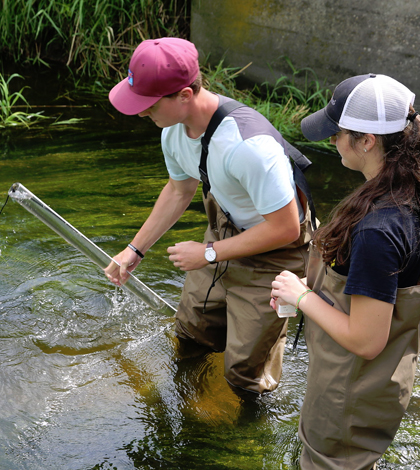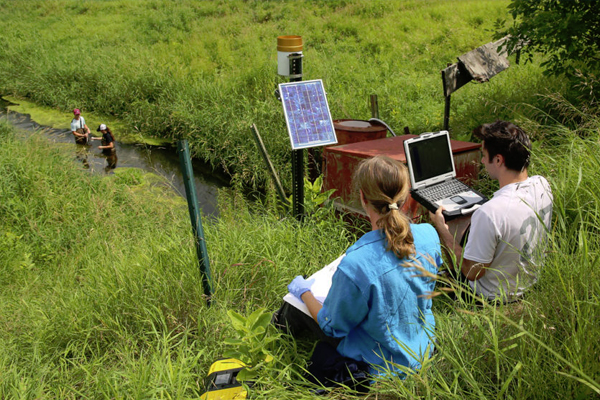In Seven Mile Creek Watershed, Students Gather Baseline Data

Student researchers sample a stream in Minnesota’s Seven Mile Creek watershed for clarity. (Credit: Gustavus Adolphus College)
Many college students prefer to relax over their summer breaks, but a few at Gustavus Adolphus College had another goal for their time off. They were looking instead to sample various streams that are part of Minnesota’s Seven Mile Creek watershed.
Their efforts completed this summer are just the first steps in a project planned for the next five to 10 years that will explore how water quality can improve when farmers and landowners nearby manage their fields in different ways. In the watershed, as well as many other areas, the hope is that updating management practices can help to make water quality better.
Sampling during this first year can gather useful baseline data to allow for gauging changes to water quality that come. It has involved checking water quality via Secchi disk and gathering discrete samples from the watershed’s streams for lab analysis. The student researchers, as well as environmental studies Associate Professor Laura Triplett who led the work, analyzed the samples’ sediments and nitrate levels. Additional data on E. coli bacteria concentrations were also gathered.
“We’re putting the puzzle together,” said Jake Westfield, a junior biology and environmental studies major. “We want to learn as much as we can about this watershed.”

Investigators interface with a monitoring station along a Minnesota River tributary. (Credit: Gustavus Adolphus College)
By taking water samples at different times of the day and through changing weather patterns, the researchers are building a database that will help them to analyze how the streams vary based on time of year, precipitation levels and farm management practices in place. The data will also help to inform future agricultural and land management practices to support cleaner rivers in southern Minnesota.
“We catch each other’s mistakes and make sure we’re always using the correct methodology,” said Westfield.
Gathering all the measurements has helped to expose the students to both lab and field science, while also giving them opportunities to interact with groups working to improve conditions in the Minnesota River basin. Some of those include the Minnesota Pollution Control Agency, U.S. Army Corps of Engineers and the University of Minnesota.
“I love the community aspect of science,” said Triplett. “People picture scientists sitting alone in a lab, but that’s not how environmental studies works. The team dynamic and energy that each student brings is what makes our project click.”
Funding for the summer project was provided by the McKnight Foundation. Additional funding and support for the Minnesota River basin research came through the Margaret A. Cargill Foundation, a Gustavus Presidential Faculty-Student Collaboration Grant, and the college’s environmental studies program.
Top image: Student researchers sample a stream in Minnesota’s Seven Mile Creek watershed for clarity. (Credit: Gustavus Adolphus College)





0 comments